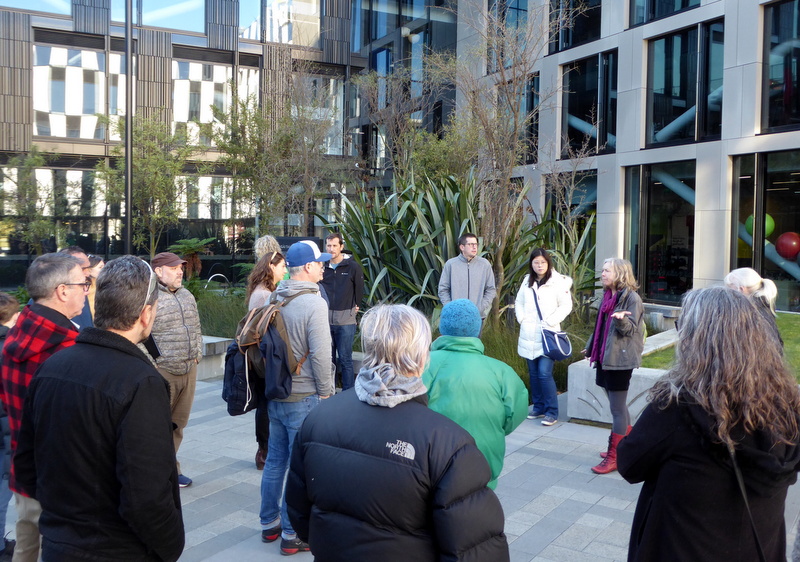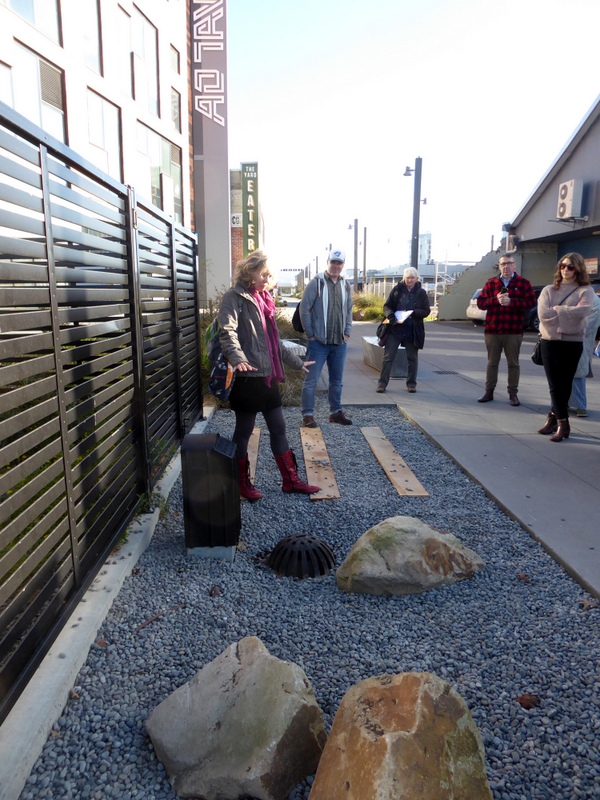
July 3rd 2021
Thanks to everyone who attended our recent water sensitivity field trip around Ōtautahi Christchurch. We learned about public and private rain gardens, trees, and policy. Here are our notes.
Rain gardens are a type of ‘green infrastructure’ that intercepts stormwater and removes pollutants that have been picked up as the rain flows over urban surfaces towards the stormwater system.
‘Engineered’ rain gardens
These are seen in central Christchurch and are doing a more complex job than home rain gardens might be. Filtering pollutants that build up on roads, like sediment, hydrocarbons, zinc and copper (eco toxins). Preventing pollutants like these entering the stormwater system and from there the rivers.
An engineered rain garden has 3 layers (from top down) underneath a mulch which suppresses weeds, traps sediment, retains moisture during dry periods and keep the roots “cool”
- A growing medium of part sand, part compost and part loam sits above. This mix is designed to allow water to permeate through at a rate slow enough that the soil and plants filter pollutants from the stormwater, and fast enough to avoid water ponding at the surface.
- A geotextile and thin sand layer are placed above.
- Bottom is a gravel layer with large gaps between the stones which fills with water creating a store and slowing the flow of water to the river.
A ‘scruffy dome’ is a giveaway that a piece of landscaping is a rain garden. It sits within a rain garden looking like an upturned colander. It is designed to divert floodwater back into the stormwater network during high rainfall events. It needs to be proud of the fill. In the rain-garden next to Ao Tawhiti school it is lying below the level of the gravel – a tendency for contractors to ‘fill up’. There is a need for education and training to make sure these relatively new devices are installed as designed.
Gravel is a common mulch used in Christchurch but is not considered by some experts to be the best to use. Mostly because it doesn’t trap the fine sediment as well as wood chip mulch and also because the organic is generally better for the plants in the rain garden. Also, the gravel means plant roots get too hot.

It is best to plant a variety of plants in a rain garden for biodiversity and because if one plant species fails others are still there. The plants can provide for bees and other insect life including indigenous invertebrates. A mix of exotic and native can be positive. However, one drawback is leaf litter with exotics so evergreens can be more useful in this context. There is a lot of replacement planting having to be done in Christchurch rain-gardens because the soil mix has been too sandy and fast draining. Periods without rain are challenging and again point to organic layers rather than gravel being best.
You cannot have a rain-garden if the water table is too high. Or if a site is contaminated. Rain-gardens reduce localised flooding, filter pollutants and help naturalise rain flow patterns to the waterways which is also important for improving their ecological value.
With an engineered rain-garden just using 3% of the surface area you can have effective rain garden function ie. they do not have to be taking a lot of space.
Where rain-gardens have been installed in the street 80% of the annual runoff is treated. Newer subdivisions have incorporated some stormwater treatment but in older built -up areas voluntary action is needed if rainwater falling on residential properties is to be treated before it flows to the rivers.
Back yard rain gardens
These can be less engineered if some basic things are considered (e.g. water table, soil permeability). They are essentially a slight depression where rainwater from the roof and/or drive collects during a storm and then soaks into the ground. Domestic rain-gardens may still need an overflow pipe connecting to the stormwater network. They will take more space, perhaps 10% of the roof or driveway area draining to the garden.
The suggestion was made to produce a practical guide booklet. Some excellent examples have been produced in the US (e.g.12,000 Rain Gardens | in Puget Sound” https://www.12000raingardens.org) and Melbourne. Video demos are also helpful. Whilst the principles are the same they need to be adapted to the local weather patterns and plant varieties.
An important function of rain gardens is the connection with nature. The more we have, with plants and related biota, then the more chance we have of re-connecting an urban population with nature including where people work. They tend to be in the ‘smart’ parts of town. We need to spread them out.
Take home for residents is that we can do this on our own property. It is much less of an engineering issue. Idea to develop a resource kit.
Best with more permeable soils. West Christchurch good for these. Areas that get boggy after rain are not suitable as they have shallow groundwater or poorly draining soil. (Have you room for trees instead?!!)
Richmond Community Gardens have a small demo at the paddling pool and are workshopping one (two?) soon.
We need some exemplars and so need to do some around the city. As well as Richmond Community Gardens what about encouraging them at schools including Enviroschools. Private people could have a go together. Something that could be facilitated.
We need nurseries getting resources together for people. Plants, kit. Guidance. Practical advice. Combine with rain harvesting – ask plumbers.
Trees
Justin Morgenroth (University of Canterbury) pointed out that simply planting trees is a great way to reduce urban runoff, while providing other ecosystem services like increasing biodiversity! Where possible, we should protect the trees that we have to help engineered solutions mitigate stormwater issues. One person lamented the loss of mature trees at the University of Canterbury while there have been rain gardens built in conjunction with new buildings.
What has happened there? We should perhaps find out.
His booklet “Tree Canopy Cover in Christchurch New Zealand”, was distributed to the attendees. It is available online here: http://dx.doi.org/10.26021/11174. It is clear some areas of the city have more tree cover than others. We discussed some of the reasons there might be for this. Lots have been lost post-quake.
Policy
Developers are required to do the bare minimum and that is therefore what they tend to do.
Could we push for this to change?
The National policy statement for Urban Development does not tie in well with the NPS on Freshwater or the Biodiversity Strategy. We need to pay attention to the developing Natural and Built Environment bill and make submissions around these issues.
We are not targeted enough toward good quality urban development.
In some areas of Auckland properties are required to hold the first 5mm of rainwater/storm water on site and this can make a substantive difference. A simple rule. Easy to do using rain harvesting; rain gardens; permeable surfaces either individually or in combination
Good urban design is more about what you don’t do than what you do. Protect trees!! Leave the good stuff alone.
Reduce the hard surface area. How much do you actually need? Looking around the cityscape there is a massive amount of hard surface that looks unnecessary and this is true in private residences as well. Hard surfaces can cause plants (and us) to suffer from heat. Another signal of how water sensitivity links both with the biodiversity and climate crises.
Thinking about pollutants, is there a need to change building regulations? Why are we still using polluting products on Christchurch buildings? Also copper brake pads.
Pollutants such as copper and zinc are shed from building materials. There is very little treatment of these pollutants in the stormwater network and so it is better to avoid using polluting materials in construction where possible. Avoiding copper facades and rainwater goods would be an easy win for the environment.
Opportunities to raise awareness
There is an ongoing maintenance issue with rain gardens in the city. Contractors and Council complain that they ‘trap litter’. A good thing perhaps as it is stopping it going straight into drains and rivers but it does need removing. Can we do more to prevent it? It looks like the gravel fill to many smokers makes rain gardens in the city look like giant ashtrays. Would interpretative signs help? What other education or other actions could help? Signs might be good to educate the rest of the public on the reason the rain gardens are there and this could indirectly affect the ones trashing them.
Engineering and aesthetics need to work hand in hand.
Combinations of natural and non-natural to appeal to people’s aesthetic and values. e.g. by the Ngai Tahu building site there is a garden with sculptures of eels etc. Charming.
At Cathedral Square we focused on the mature trees. They are successful and get plenty of water despite the constructed look. However, it would definitely be better if there were diverse plants under them rather than grass. We are hoping this will be part of the Square’s redevelopment which is in the pipeline currently. The intention is for ‘greening’ but let’s have cleaning the water and education as part of the plan. A particular opportunity here is the proximity of the river. The James Lundy design is still sitting at Council. This is the main vision plus the Ngai Tuāhuriri vision of extensive gardens serving a function -with the softness/ the inviting/ the engaging – to encourage the connection with nature.
Other thoughts
“The Rain garden City”
“National Park City”
A lot discussed from 2011- 2015 that has not been acted on.; let’s push people to do it.
Why do some cities do well with this? Vicky talked about the impact of Third Sector organisations pushing for change.
Giving away trees. International examples also provide rates reductions for properties with trees.
We could look at Berms. Need guidelines for berms in Christchurch what we can do on them.
Bit by bit. Cumulative. Keep going, don’t lose sight and hope!
Overall big picture.
The more we can do to keep stormwater off the streets the better for our stormwater systems (and sewage if there is overflow). On site solutions can take pressure off (and reduce cost for) the large constructed wetlands and other centralised infrastructure.
There are biodiversity wins with water sensitive design BUT don’t forget to plant TREES!!!



Thank you, very interesting.